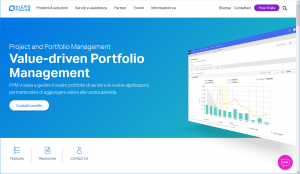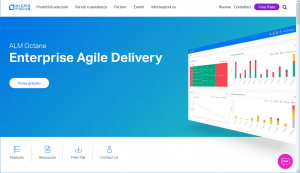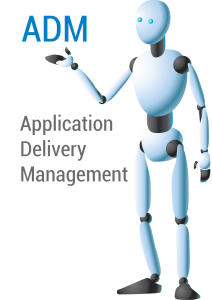Application Delivery Mangement
A project can be considered as a set of activities and tasks characterized by the following properties:
- a well-defined goal to be achieved by respecting certain specifications
- a predetermined start and end date
- a pre-established budget
- a number of resources identified a priori
The SW industry is full of projects’ examples that do not meet the expectations defined in the initial phase:
- projects which cost much more than estimated and which are completed later than expected
- projects that do not end because the complexity has not been managed
- projects that, although formally concluded, in the field test prove inadequate to meet customer expectations
The causes can be innumerable, but they have a common root: a management not supported by effective methods.
A project initiative usually starts from an internal requirement in the customer’s business process, and must be tackled by distinguishing two aspects:
- Management process (Project Management)
- Technical process (SW engineering)
The management process is well defined and declined in its various aspects by the Project Management Institute in the PMBOK, while the technical process has been addressed by the regulations defined by the IEEE Computer Society and over the years has led to the definition of multiple approaches, each of which certainly has many strengths but also some flaws; the choice of the most suitable approach should always be based on the specific characteristics of the project initiative, as recalled by the UNI EN ISO 9000: 2015 standard, and as the market imposes when it asks for a predefined ability to respond to ever new problems and always more uncertain.
An operational hypothesis to reach the definition of SW processes in an Organization can be summarized with:
- Strategic business management
- Governance of the organizational structure
- Acquisition of the SW methodology
In an organization attentive to the innovation of its technology, the company methodology (business strategy) necessarily precedes and hosts the SW methodology (product realization strategy): you therefore enter the Top Management ‘s sphere of responsibility.
The definition of the sw processes must therefore be seen as a flexible production system, developed in accordance with the business strategy.
Our professionals, in addition to the many years of experience acquired in the management of highly complex projects and programs, also have a deep knowledge of Project Management best practices, certifications on the main methodologies (PMP, Agile Scrum Master), and excellent knowledge of the Microfocus portfolio’s solutions for Application Delivery Management (ADM), which are market leaders in the primary and support processes described below.
The ISO / IEC 12207 standard suggests a division of the processes into:
- Primary processes
- Acquisition
- Provision
- Development
- Exercise
- Maintenance
- Support processes
- Documentation
- Configuration management
- Quality assurance
- Check
- Validation
- Review
- Audit
- Troubleshooting
- Organizational processes
- Direction
- Infrastructure
- Improvement
- Training
The generic structure of a directional process is also defined in ISO / IEC 12207:
Structure of a generic management process |
|
Starting and definition purposes |
|
Planning |
|
Execution |
|
Control reviews and evaluations
|
|
Closing |
|
The organizational structure’s governance hosts the process of acquiring the methodology. An incisive management capable of adapting the organizational structure to market conditions should give answers to the following questions:
- What development processes need to be defined?
- Which and how many methodologies should be acquired?
- How to connect the definition of processes and the definition of methodologies?
There is no valid answer for every context: we believe that every Organization must commit itself, case by case, to finding the best solution in relation to the mission, the market and the available resources.
An organization that works on projects cannot formulate a single production function ( because each project is different from another in terms of product and customer / user ) and cannot define the development process from scratch every time it has to implement a new solution.
The ability to customize the process on the characteristics of the new solution to be implemented is essential for the success of the project.
On one hand, therefore, organizations must establish rules to regulate their processes, on the other hand the rigidity of the rules with respect to market objectives creates a divergence between the quality defined “on paper” and the real quality of products and processes .
To avoid this duality, an organization must have a flexible quality management system that can model itself on the specific flow of the new project. It is as if once the requirements of the product to be made have been defined, the organization should equip a specific “production line”; this is possible only if the Organization has in its technological patrimony a scheme of production lines adaptable and customizable to each new project.
All this can be achieved with solutions and professionals able to implement this “highly flexible and customizable production line”.
The fundamental solutions for complete and flexible project management are:
Project & Portfolio Management
PPM solutions help manage the portfolio of services and applications, allow you to align the flow of requests with the corporate strategy and to optimize the processes and governance, to provide value to your company.
Market leader solution: Microfocus PPM 
Link: https://www.microfocus.com/it-it/products/ppm-it-project-portfolio-management/overview
With MF PPM you can count on:
- A deep and reliable knowledge of data: with a top-down and bottom-up data analysis, PPM provides hundreds of portlets with reliable data to align business investments with the commercial strategy.
- Value-driven Portfolio: You can create your own portfolio of projects to quickly bring value to your business. You can continuously monitor key KPIs and take advantage of the “what if” scenario to determine the right relationship between deliverable products and investments.
- A solution prepared for corporate Agile: You can easily manage hybrid projects (legacy and Agile). PPM integrates ready-to-use tools with the most popular Agile tools, including ALM Octane, Agile Manager, CA Rally, Jira, VersionOne and others
- Program, project and request integration: The integrated features of PPM allow you to manage entire programs, specific projects or even individual requests. You have complete control of the risks and resources, which help you to successfully complete your projects
- Flexible workflow: PPM helps you in project governance and compliance management, with a graphic and flexible workflow that automates processes with integrated PPM modules.
- Open Platform: Provided on site or via the SaaS platform, PPM offers dozens of ready-to-use integrations plus an open API to transfer data from other applications.
Quality and Safety
Application Lifecycle management and Automatic Testing solutions help increase developer efficiency by 25% and improve Sw quality.
Market-leading solution: ALM Octane
Link: https://www.microfocus.com/it-it/products/alm-octane/overview
With MF ALM Octane:
- 40% faster software delivery and 25% better developer efficiency
- Continuous quality and safety is guaranteed, with timely and frequent tests to correct defects, identify risks and architectural problems in a fully traceable way.
Applications’ Delivery
The DevOps approach is a model, or rather a work philosophy, which intends to create a culture and an environment in which design, testing and release of software can take place quickly, frequently and efficiently. It is based on the synergy between corporate culture, practices and tools and provides organizations that adopt it with the ability to develop applications and services with maximum agility, allowing the evolution and improvement of products at a faster pace than traditional systems. Greater agility translates into better customer services and, consequently, greater competitiveness on the market.
With DevOps you can:
- define a hybrid environment, suitable for specific needs;
- manage multiple releases;
- manage all types of tests (manual, automatic, regression, performance);
- identify defects;
- integrate code changes;
- track all results;
- define work environments for individual users;
- solve the assigned malfunctions;
- guarantee the quality of the applications;
- use customizable views in the dashboard module;
- speed up delivery of applications;
- increase the reliability of the service;
- modernize core business systems.
You can also discover and resolve security vulnerabilities quickly and promptly with Application Security DevSecOps.



